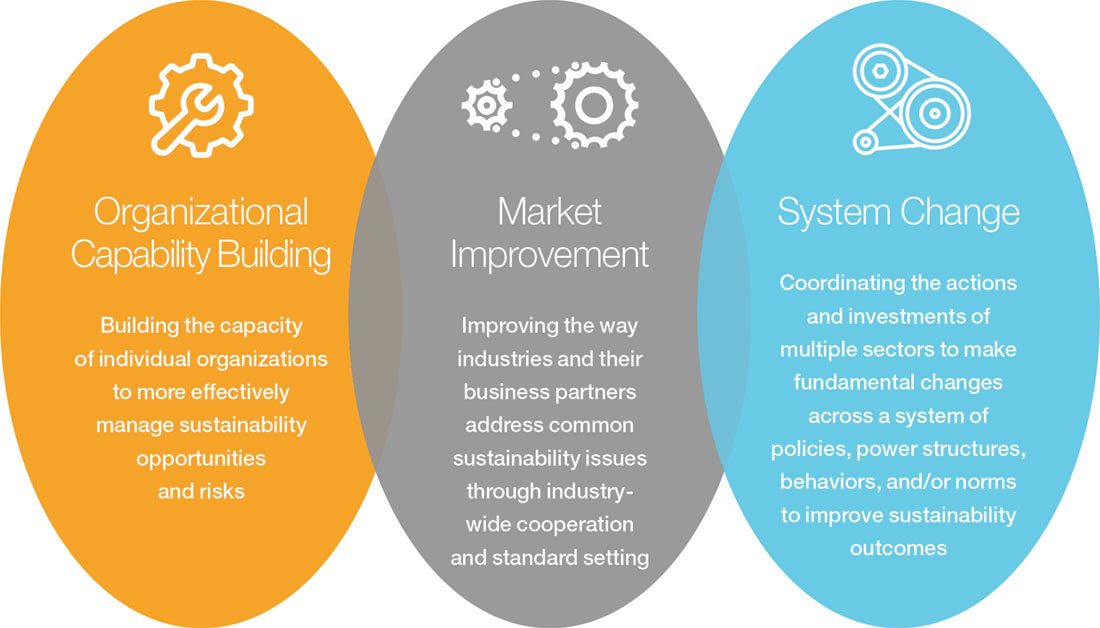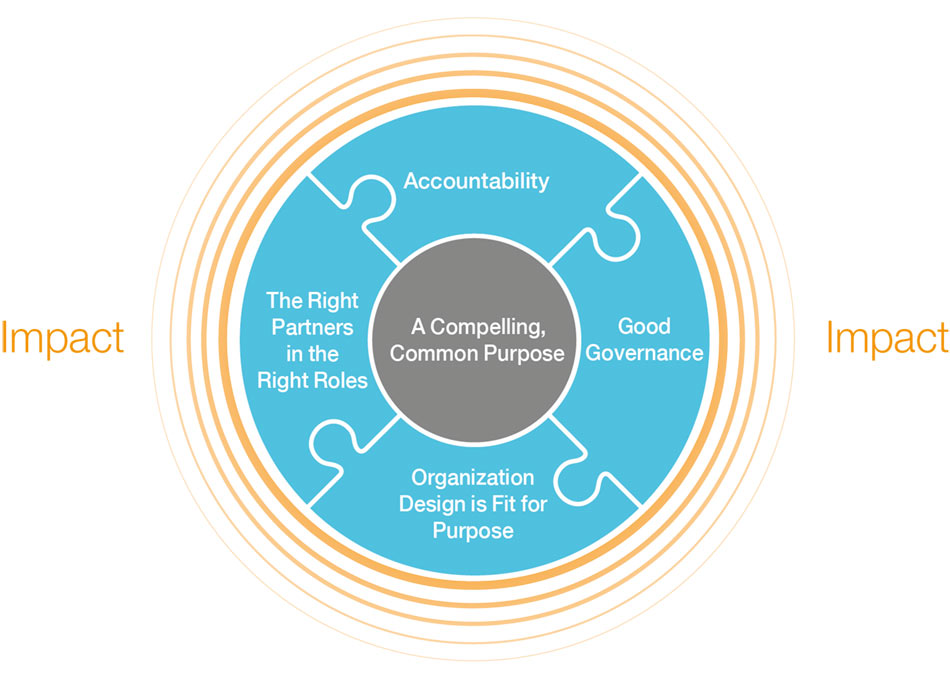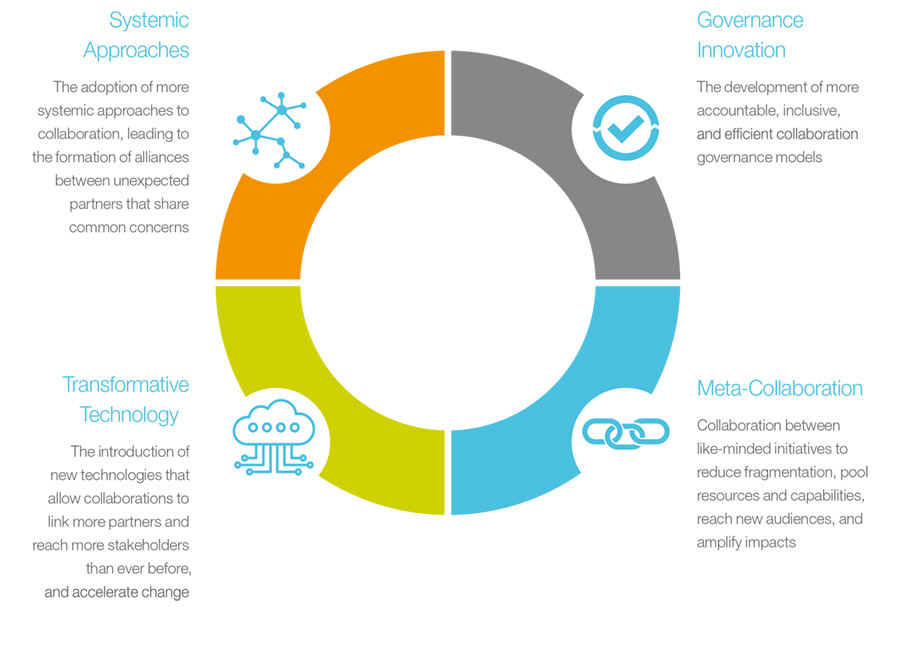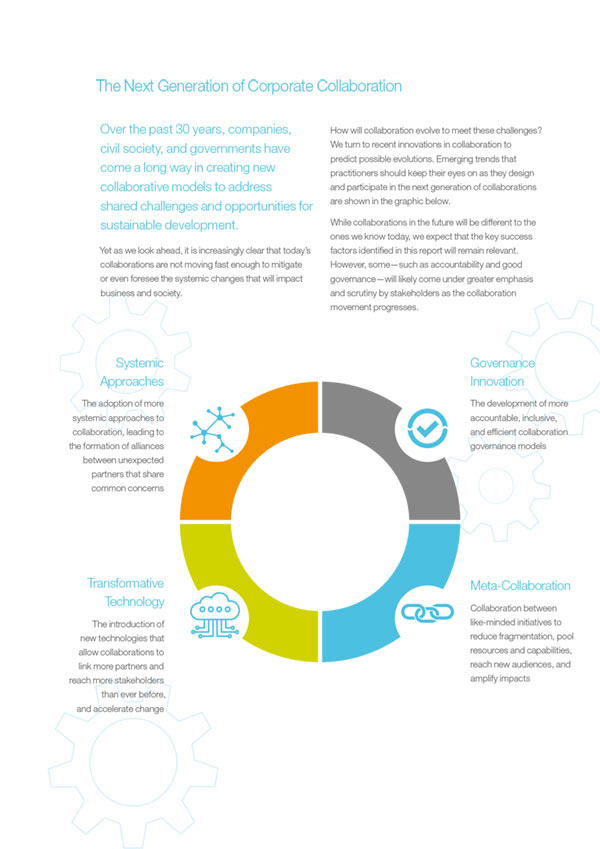Why Read This?
In the past year, it has become increasingly clear that the world is changing fast—and profoundly. We are faced with challenges such as catastrophic climate change, increasing inequalities, and the rapid emergence of new technologies that disrupt societies and raise new, fundamental ethical questions.
To tackle these challenges, we must transcend the status quo of individual actions to foster collaboration for impact at scale. We need well-designed, well-governed, accountable, and impactful collaborations.
Drawing on BSR's 25 years of experience in designing, implementing, and scaling collaborative initiatives, this report identifies the characteristics of successful collaborations and helps companies better understand how to prepare for and contribute to their success.
Chapter 1
Why Companies Collaborate
Defining Collaboration
For the purposes of this report, we focus on voluntary efforts that engage multiple participants from the private sector in noncommercial, precompetitive collaboration. Such initiatives require participants to:
- Work together to achieve a common purpose and/or specific outputs.
- Share risks, responsibilities, resources, and benefits.
- Adhere to a process for decision-making and action, including shared rules, norms, and structures.
Why Collaborate? Commonly Cited Motivations for Corporate Participation in Collaboration
The BSR Collaboration Taxonomy
The collaborations reviewed for this report exhibit a very wide range of characteristics, all unified around the common purpose of advancing business interests and sustainable development. BSR finds it useful to organize the universe of collaborations based on the scope of change that a collaboration seeks: organizational, market, or system change. While all collaborations across the taxonomy are focused on action and impact, the targeted scope of change influences the design of the initiative, including decisions about objectives, activities, composition, organization, and governance.

Chapter 2
The Key Success Factors of High-Impact Collaboration
While the aims of collaborations may differ markedly, our research suggests that successful private-sector collaborations of all kinds display certain characteristics that must be in place to enable them to advance progressively toward their vision and mission. It also suggests that considering these factors in the design of new collaborations is necessary for success.
We identified five common factors that, combined, offer a blueprint for high-impact collaborations. A winning design includes:
- A compelling, common purpose that brings participants together and enables each to accrue value from the collaboration
- The right partners in the right roles that bring the required authority and resources to drive the collaboration forward
- Good governance that enables efficient, transparent, and fair decision-making
- An organizational design that is fit for purpose—with sufficient resources and staffing to operate
- Accountability to the objectives the collaboration participants have committed to

Common Risk Factors
Addressing the five key success factors when designing and managing collaborations will provide a robust foundation for an initiative. However, the five factors do not guarantee success. It is essential that collaborations retain the agility and flexibility to respond to context changes through an ongoing assessment of the collaboration's strategy and design relative to the external environment.
In addition, there are a number of common risk factors that may imperil collaborations. Factors identified by those interviewed for this report spread across the lifecycle of the collaboration. Recognizing them can allow participants in a collaboration to act and avoid failure.
Start-Up Phase
- Prioritizing collaboration over other, more direct interventions
- Duplicating efforts of other collaborations
- Lack of a "burning platform" to gain initial traction
- Launching prematurely, before participants have bought in
- Lack of business value for private-sector participants
Early Implementation Phase
- Negotiation breakdowns between critical participants
- Insufficient resources to meet the ambitions of the collaboration
- Breaches of trust between participants
- Participant turnover
Scaling Phase
- Lack of leadership succession planning
- Mission creep
- Loss of enthusiasm/energy diverted to new projects
- Inability to pivot to accommodate new external forces
- Lack of a strategy for sunsetting
Chapter 3
How Companies Can Prepare
In addition to the design of the initiative, our research underlines that collaboration success is highly contingent on the preparedness and commitment of participants. Even the most thoughtfully designed collaboration will founder when participating organizations are not prepared to collaborate. Participants are often surprised by the level of preparation, resource allocation, time, and commitment to the long game required to be successful in their collaborative efforts.
Our guidance to individual companies seeking to achieve impact through collaboration is organized around three basic principles: systematically evaluating, investing in, and committing to the collaborative initiatives that are critical to business success and social value creation. These preparatory steps also reinforce the key success factors for high-impact collaborations, ensuring that the company's contributions strengthen the initiatives they participate in.
Evaluate
Companies need to invest time and resources in appropriately evaluating whether and how collaboration yields impact and business results. From the outset, companies should confidently and positively confirm that collaboration is the best answer to addressing a problem or delivering a solution. Secondly, collaborations are not created equal: Some will be more effective or better suited to deliver on company objectives. Establishing the business case for engagement is essential for generating sustained commitment, as well as for securing required internal and external buy-in. Thirdly, companies should identify any possible red lines that will determine how it may engage (or not) with a collaboration.
Collaborations are only useful when they raise the bar. That means we and our companies need to be committed to raising the bar, and to making it happen. Let's be more direct, less comfortable, and challenge each other.
Invest
Once the company has identified the collaborations it will participate in, the next step is to determine what level of support the company should and can provide to resource the effort. This involves securing internal leadership support, allocating resources, and staffing the right people to participate and represent the company.
It may be helpful to think of collaborative efforts as another form of R&D: a business function that requires some space, time, and resources in order to deliver value back to the company in the form of new ideas, approaches, products, and services. Staff who participate in the collaboration can then deliver on the company's responsibilities and confidently make decisions on behalf of the company.
Collaboration needs to be part of normal business, integrated into the way we run our projects. It is not just a task of the sustainability team, but of all teams.
Commit
The companies that get the most out of collaborative efforts make a deep commitment to ensuring their success. They integrate learnings from the partnership to align key internal functions such as public relations, government relations, procurement, and legal teams in support of the collaboration's objectives. They play active roles in the collaboration, joining governance bodies, taking accountability for their responsibilities, and providing timely feedback to ensure the initiative moves ahead. They champion the effort internally, taking the lead on implementation and piloting the collaboration's concepts, as well as externally, leveraging their relationships to encourage other companies and critical partners to engage. Finally, they are patient, and remain committed to the long haul.
Conclusion
The Next Generation of Corporate Collaboration
Over the past 30 years, companies, civil society, and governments have come a long way in creating new collaborative models to address shared challenges and opportunities for sustainable development. Yet as we look ahead, it is increasingly clear that today's collaborations are not moving fast enough to mitigate or even foresee the systemic changes that will impact business and society.
How will collaboration evolve to meet these challenges? We turn to recent innovations in collaboration to predict possible evolutions. Emerging trends that practitioners should keep their eyes on as they design and participate in the next generation of collaborations include:
- The introduction of new technologies that allow collaborations to link more partners and reach more stakeholders than ever before, and accelerate change.
- The development of more accountable, inclusive, and efficient collaboration governance models.
- The adoption of more systemic approaches to collaboration, leading to the formation of alliances between unexpected partners that share common concerns.
- Collaboration between like-minded initiatives to reduce fragmentation, pool resources and capabilities, reach new audiences, and amplify impacts.

Transformative Technology
The introduction of new technologies that allow collaborations to link more partners and reach more stakeholders than ever before, and accelerate change.


Meta-Collaboration
Collaboration between like-minded initiatives to reduce fragmentation, pool resources and capabilities, reach new audiences, and amplify impacts.
While collaborations in the future will be different to the ones we know today, we expect that the key success factors identified in this report will remain relevant. However, some—such as accountability and good governance—will likely come under greater emphasis and scrutiny by stakeholders as the collaboration movement progresses.
Toward Collaborative Leadership
The recommendations offered in this report will bring companies to a more efficient and effective strategy for collaboration: a big step in the right direction. Yet companies that aim to truly take the lead on resolving sustainability issues—particularly those that are systemic in nature—need to consider more profound mindset, talent, and business model transformations.
It will take a change in mindset to recognize collective gains as an individual opportunity. Companies will need to develop a level of comfort with joint problem-solving and decision-making, with taking leadership positions in situations of uncertainty, and with sparking a social movement for change over "getting there first." CEOs and boards of directors must step up to defend collaborative actions that may be unprofitable in the short term but that advance the sustainability of the ecosystem that supports their entire industry over the long term.
In order to meet the challenges ahead, we must together summon the courage to evolve beyond competition to celebrate business leadership that contributes to collective success.
How would you, could you, operate if you didn't need to take credit, and could collaborate fully and honestly?
PDF Versions
Let’s talk about how BSR can help you to transform your business and achieve your sustainability goals.









